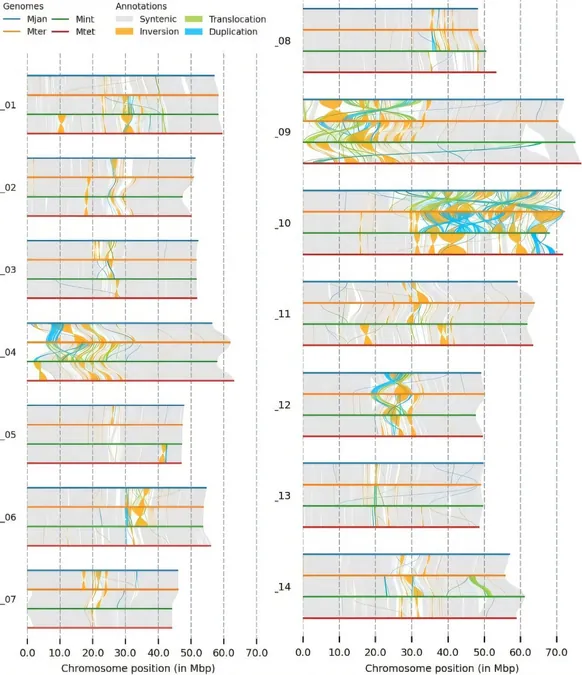
Unlocking the Secrets of Macadamia: A Revolutionary Genomic Breakthrough for Crop Improvement!
2024-11-04
Author: Sophie
Revolutionary Genomic Breakthrough
In an exciting development for agricultural science, a dedicated research team has successfully sequenced and assembled the genomes of all four Macadamia species, paving the way for transformative improvements in crop cultivation and resilience. This landmark achievement unveils crucial genetic traits that can significantly enhance disease resistance, climate adaptability, and overall crop yield for this premium nut, which has seen a surge in global demand.
Understanding Macadamia Species
Originating from the lush landscapes of eastern Australia, the Macadamia genus encompasses four species: Macadamia integrifolia, M. tetraphylla, M. ternifolia, and M. jansenii. Of these, only M. integrifolia and M. tetraphylla are cultivated commercially, primarily in Hawaii and Australia. However, the limited genetic base of these species has created challenges for breeders seeking to improve crop diversity and resilience against environmental challenges.
The Breakthrough Study
The groundbreaking study, published in the esteemed journal Tropical Plants on October 21, 2024, aims to broaden the genetic resources available for macadamia cultivation. The research team harnessed the power of PacBio HiFi long-read sequencing technology, achieving impressive sequencing depths between 27X and 42X. This resulted in highly contiguous genomes with N50 values exceeding 45 Mb—signifying exceptional genome completeness and paving the way for superior breeding programs.
Key Findings
Among the sequenced species, M. integrifolia boasted the highest number of genomic contigs, while M. tetraphylla was recorded with the least. Remarkably, the BUSCO analysis confirmed over 97% genome completeness, with the majority of genes identified as single-copy, ensuring a reliable foundation for future research.
Chromosome-Level Assemblies
The chromosome-level assemblies revealed genome sizes ranging from 735 Mb to 795 Mb, crucial for understanding the genetic architecture of macadamia. Noteworthy findings included the identification of structural variations across chromosomes and the revelation that 61% to 62% of these genomes consist of repetitive elements. Surprisingly, the estimated number of predicted genes spanned from 37,198 to 40,534, opening up new avenues for exploration.
Genetic Insights
Among other insights, genes linked to fatty acid biosynthesis and antimicrobial properties were found to be conserved across the various Macadamia species, highlighting the underlying genetic potential that can be harnessed for breeding. By examining comparative genomic structures, the research identified significant differences that enhance our understanding of genetic diversity within this lucrative genus.
Expert Commentary
Dr. Robert J. Henry, the study's lead researcher, stated, “Access to the genomes of all four macadamia species opens up extraordinary opportunities for improving crop resilience and productivity. This detailed genomic data lays the groundwork for innovative breeding programs, essential for meeting the challenges posed by a changing climate and soaring global market demands.”
Implications for Agriculture
The implications of this research are profound: not only does it herald the potential for increased production and resilience of macadamia crops, but it also equips breeders and researchers with critical tools to secure the future of this economically vital crop. As the world faces escalating agricultural challenges, such as climate change and pest pressures, the advances in macadamia genomics could shine a light on sustainable farming practices and strategies.
Looking Ahead
The future of macadamia cultivation looks brighter than ever, and as these innovations unfold, growers and consumers alike can anticipate a new era of sustainable, delicious, and highly nutritious macadamia nuts. Stay tuned as we continue to monitor this remarkable journey in agricultural science!









 Brasil (PT)
Brasil (PT)
 Canada (EN)
Canada (EN)
 Chile (ES)
Chile (ES)
 España (ES)
España (ES)
 France (FR)
France (FR)
 Hong Kong (EN)
Hong Kong (EN)
 Italia (IT)
Italia (IT)
 日本 (JA)
日本 (JA)
 Magyarország (HU)
Magyarország (HU)
 Norge (NO)
Norge (NO)
 Polska (PL)
Polska (PL)
 Schweiz (DE)
Schweiz (DE)
 Singapore (EN)
Singapore (EN)
 Sverige (SV)
Sverige (SV)
 Suomi (FI)
Suomi (FI)
 Türkiye (TR)
Türkiye (TR)